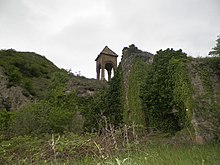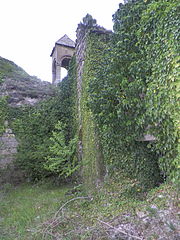Madagiz
Madagiz
Մատաղիս • Mataghis | |
|---|---|
| Suqovuşan | |
 Residential houses in the village, 2011 | |
| Coordinates: 40°19′33.1″N 46°45′00.8″E / 40.325861°N 46.750222°E | |
| Country | |
| District | Tartar |
| Elevation | 434 m (1,424 ft) |
| Population (2015)[1] | |
• Total | 665 |
| Time zone | UTC+4 (AZT) |
Madagiz (Armenian: Մատաղիս, romanized: Mataghis) or Sugovushan (Azerbaijani: Suqovuşan,[a] ), is a village in the Tartar District of Azerbaijan. The village had an ethnic Armenian-majority population prior to the 2020 Nagorno-Karabakh war.[3] Madagiz was part of the Martakert Province of the breakaway Republic of Artsakh between 10 April 1994 and 3 October 2020.
History

In 1943, during the Soviet period, Madagiz was given the status of an urban-type settlement within the Mardakert District of the Nagorno-Karabakh Autonomous Oblast.[4] In 1949, Madagiz was home to an industrial complex, including a furniture factory and a lime production workshop. In 1953, a secondary school was opened. The Madagiz hydroelectric power station was built nearby on the banks of the Tartar River.
During the First Nagorno-Karabakh War, Azerbaijani forces launched an offensive into the Mardakert District in the summer of 1992, capturing most of the district. However, as the result of a counter-offensive, by the end of June 1993, Armenian forces managed to take control of almost the entire district. After the war, the village was administrated as part of the Martakert Province of the Republic of Artsakh.[5]
In April 2016, during the Four-Day War, the village found itself in the area of direct hostilities.[6][7][8] The village was captured by Azerbaijan on 3 October 2020, during the 2020 Nagorno-Karabakh war, with the Azerbaijani government renaming the village to Suqovuşan.[9]
Historical heritage sites
Historical heritage sites in and around the village include tombs from the 2nd-1st millennia BCE, a 12th/13th-century khachkar, the Yeghishe Arakyal Monastery from between the 13th and 18th centuries with an adjacent chapel-mausoleum built in 1286 dedicated to Vachagan III (Armenian: Վաչագան Բարեպաշտի մատուռ-դամբարան, romanized: Vachagan Barepashti Matur-Dambaran), a two-storey building from 1552, the St. Yeghishe Church (Armenian: Սուրբ Եղիշե եկեղեցի, romanized: Surb Yeghishe Yekeghetsi) from 1892-1898, and an 18th/19th-century cemetery.[1]
Geography
The village is located 30 kilometers northwest of the left bank of the river Tartar. To the west of the village lies a reservoir, which was created to supply water to the Tartar, Goranboy, and Yevlakh Districts of Azerbaijan.[10]
Economy and culture
In 2015, the population was mainly engaged in agriculture and animal husbandry, and the village had a municipal building, a secondary school, a kindergarten, and a medical centre.[1][11]
Sugovushan-1 and -2
The reconstructed hydroelectrical power plants Sugovushan-1 and Sugovushan-2 have the total capacity of 7.8 MW.[12]
Demographics
In 1970, 271 people (236 Armenians, 30 Azerbaijanis, 44 Russians and nine Ukrainians) lived in the village.[13] Madagiz also had an Armenian majority-population in 1989.[3]
The village had 404 inhabitants in 2005,[14] and 665 inhabitants in 2015.[1]
According to the State Committee for Refugees and Internally Displaced Persons of Azerbaijan, as of 2020, 66 internally displaced persons from Madagiz were living in Azerbaijan.[15]
Gallery
-
Church of St. Yeghishe in the northwestern part of the village
-
Armenian khachkars in the wall in the monastery of St. Yeghishe
-
Countryard of the monastery of St. Yeghishe
See also
Notes
References
- ^ a b c d Hakob Ghahramanyan. "Directory of socio-economic characteristics of NKR administrative-territorial units (2015)".
- ^ "Ilham Aliyev: I restore historical name of Madagiz, it is henceforth called Sugovushan". 3 October 2020.
- ^ a b Андрей Зубов. "Андрей Зубов. Карабах: Мир и Война". drugoivzgliad.com.
- ^ "Archived copy" (PDF). Archived from the original (PDF) on 2018-11-27. Retrieved 2020-10-13.
{{cite web}}: CS1 maint: archived copy as title (link) - ^ "В Нагорном Карабахе прошли соревнования по борьбе, посвященные очередной годовщине освобождения Мартакерта" [Wrestling competitions dedicated to the anniversary of the liberation of Martakert were held in Nagorno-Karabakh]. regnum.ru (in Russian). Retrieved 2020-10-13.
- ^ "Pakistan ordusu yeni raketini sınaqdan çıxardı - VİDEO". BAKU.WS - Azərbaycanın xəbər saytı (in Russian). Retrieved 2020-10-13.
- ^ "Ադրբեջանական կողմի տեղեկությունը, թե Մատաղիս բնակավայրը իրենք գրավել են, սուտ է. 2 ժամից ավելի է՝ Մատաղիսում եմ, ոչ մի ազերի վիժվածք չկա. ՖՈՏՈՌԵՊՈՐՏԱԺ, ՏԵՍԱՆՅՈՒԹ". Լուրեր Հայաստանից | Shamshyan.com (in Armenian). Retrieved 2020-10-13.
- ^ "Müdafiə Nazirliyi". 2016-09-07. Archived from the original on 2016-09-07. Retrieved 2020-10-13.
- ^ "Azerbaijan forces take control of seven villages near Nagorno-Karabakh - president". TASS. Retrieved 2020-10-22.
- ^ "Спустя 28 лет вода из Суговушана пущена в реку Тертер". Информационное Агентство Репорт (in Russian). Retrieved 2020-10-13.
- ^ Toronto Armenian community renovates school in Karabakh, October 1, 2016
- ^ "Plans for restoration of Karabakh power system announced". Report News Agency. Retrieved 6 August 2022.
- ^ "Мардакертский район 1970". www.ethno-kavkaz.narod.ru. Retrieved 2020-10-13.
- ^ "The Results of the 2005 Census of the Nagorno-Karabakh Republic" (PDF). National Statistic Service of the Republic of Artsakh.
- ^ Азербайджан раскрыл численность населения освобожденных от оккупации населенных пунктов. Minval. 12 октября 2020.






